Real gross domestic product (GDP) rose 0.8% in the first quarter, after posting no change in the previous quarter. Favourable international trade and growth in household spending were moderated by slower inventory accumulations as well as declines in housing investment and business investment in machinery and equipment. Final domestic demand increased 0.7% in the first quarter of 2023 after remaining flat in the fourth quarter of 2022.
Chart 1
Real gross domestic product and final domestic demand
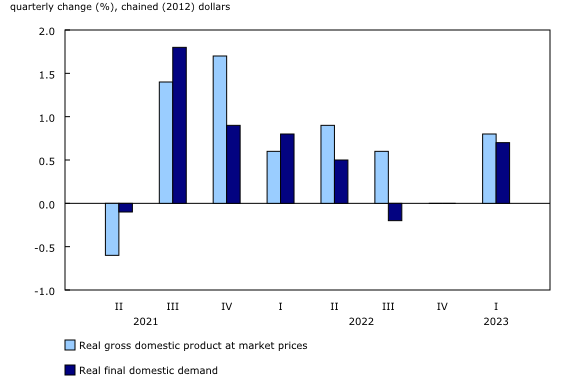
Chart 2
Contributions to percentage change in real gross domestic product, first quarter of 2023

Exports rise, imports edge up
Exports of goods and services rose 2.4% in the first quarter of 2023, following a 0.5% increase in the fourth quarter of 2022. The increase in the first quarter was led by passenger cars and light trucks, unwrought gold, silver, and platinum group metals and their alloys, other crop products, and wheat.
Chart 3
Top contributors to real exports, first quarter of 2023
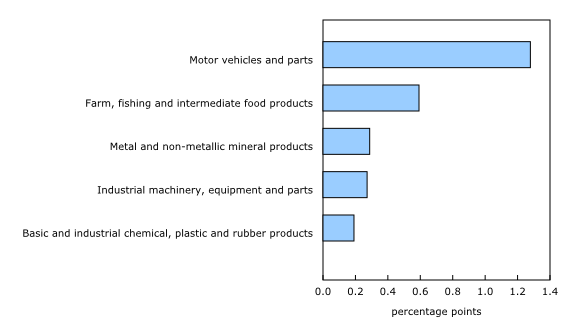
Imports of goods and services edged up 0.2% in the first quarter of 2023, following a 3.3% decline in the fourth quarter of 2022. Higher imports of crude oil and crude bitumen led the increase, followed by pharmaceutical and medicinal products, and travel service expenses by Canadians abroad. These gains were largely offset by declines in imports of passenger cars and light trucks, unwrought gold, silver, and platinum group metals and their alloys, and clothing, footwear, and accessories.
Higher household spending spurs growth
After two quarters of minimal growth, household spending rose for both goods (+1.5%) and services (+1.3%) in the first quarter of 2023. Expenditures on durable goods (+3.3%) were driven by motor vehicles including new trucks, vans, and sport utility vehicles (+7.8%). Spending on semi-durables (+4.3%) was led by garments (+4.5%), while spending on non-durable goods (-0.2%) declined slightly.
Chart 4
Real household final consumption of durable goods, semi-durable goods, and services
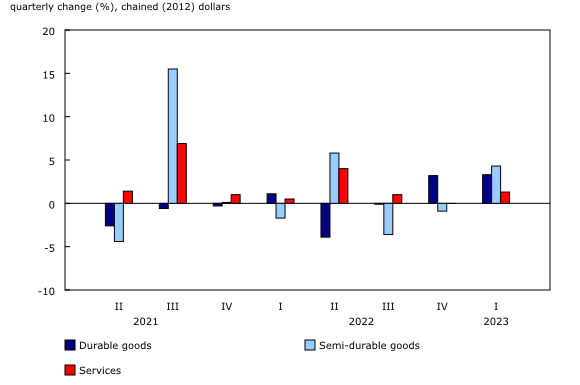
Service spending picked up in the first quarter of 2023, led by food and non-alcoholic beverage services (+4.4%), and alcoholic beverage services (+6.5%). Meanwhile, travel was on the rise with expenditures by Canadians abroad up 6.8% in the first quarter, compared with a 3.3% decrease in the previous quarter.
Housing investment continues to decline
Coinciding with higher borrowing costs and slowing mortgage borrowing, housing investment fell 3.9% in the first quarter of 2023, the fourth consecutive quarterly decrease. The decline in investment was widespread—as new construction (-6.0%), renovations (-2.1%), and ownership transfer costs (-1.5%), which represents resale activity, were all down. The decline in new construction was observed in every province and territory except Yukon.
Business investment in machinery and equipment declines
Business investment in machinery and equipment fell 2.5% in the first quarter of 2023, the third consecutive quarterly decline. The decrease was led by lower spending on medium and heavy trucks, buses and other motor vehicles, and aircraft and other transportation equipment.
The declines in business investment were partly offset by increased investment in engineering structures by the oil and gas industry and higher business investment in intellectual property products, largely stemming from software.
Inventory accumulation slows
Lower inventory accumulations in the first quarter applied downward pressure on GDP growth, the smallest change in inventories since the fourth quarter of 2021. Declines in farm inventories as well as in the stock of durable goods, such as in motor vehicles, contributed to the limited inventory accumulation.
Terms of trade declines and gross domestic product implicit prices rise
The ratio of the price of exports to the price of imports—the terms of trade—fell 2.7% in the first quarter of 2023, primarily because of a 3.4% decline in prices of exported goods. This was the third consecutive quarterly decrease in the terms of trade, as prices of exported goods continued to fall after reaching a record high in the first two quarters of 2022.
Chart 5
Gross domestic product price indexes, selected components

The GDP implicit price index—a measure of economy-wide prices—edged up 0.2% in the first quarter of 2023, primarily because of higher household expenditure prices. The price index for household final consumption expenditure (excluding food and energy) rose 1.0% in the first quarter, the 11th consecutive quarterly increase, as inflation remained elevated above the Bank of Canada’s target.
Compensation of employees up
Compensation of employees rose 1.7% in the first quarter, following a 1.2% increase in the previous quarter. This was the largest quarterly growth in compensation of employees since the second quarter of 2022.
The total wages and salaries paid in the goods-producing industries rose 2.3% in the first quarter of 2023, while total wages and salaries paid in the service-producing industries grew by 1.6%. The major contributors to wage growth in the first quarter were professional and personal services (+3.2%), manufacturing (+2.8%) and construction (+2.0%).
Map 1
Compensation of employees, quarter-to-quarter % change, seasonally adjusted data
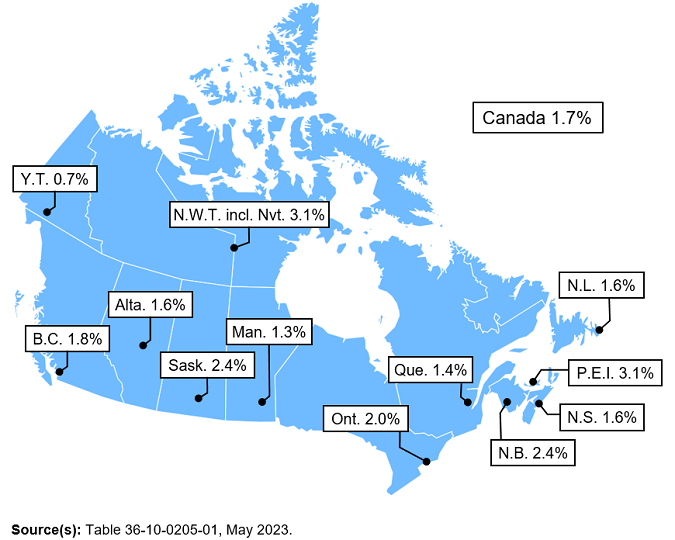
Compensation of employees increased in all provinces and territories in the first quarter of 2023. Growth was highest in Nunavut and the Northwest Territories (+3.1%) and Prince Edward Island (+3.1%), followed by New Brunswick (+2.4%) and Saskatchewan (+2.4%). Growth was lowest in Yukon (+0.7%).
Household saving rate falls on lower disposable income
Household disposable income decreased by 1.0% in the first quarter, the first reduction since the fourth quarter of 2021. Although strong labour and housing market conditions had a positive impact on compensation of employees (+1.8%) and rental income (+4.7%), these gains were more than offset by decreases in current transfers received (-5.8%) and net property income (-2.4%).
Chart 6
Household sector, selected components, seasonally adjusted, annual rates
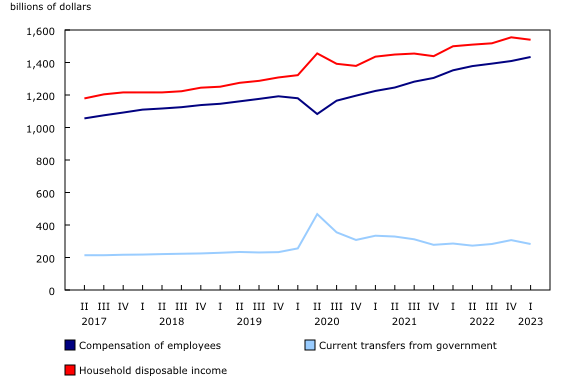
Current transfers received were lower in the first quarter of 2023 as the previous quarter included the GST top-up, as well as various provincial measures to ease the impact of inflation. The first quarter also reflected repayments of various COVID-19 support benefits. As well, persistently high interest rates had a predominantly negative effect on net property income, as increases in interest income (+6.4%), mainly from deposits, did not keep pace with higher interest payments on mortgages (+14.7%) and consumer credit (+10.9%).
In contrast with lower disposable income, consumption expenditures (in nominal terms) rose 2.1% in the first quarter of 2023. This was a faster pace than the 1.4% recorded in the fourth quarter of 2022 partly due to inflationary pressures. As a result, the household saving rate was 2.9% in the first quarter of 2023, down from 5.8% at the end of 2022. The household saving rate approached the pre-pandemic level, which averaged 2.1% in 2019.
Corporate incomes weaker
After declining in the last half of 2022, the incomes of non-financial corporations continued to fall in the first quarter of 2023. Overall, gross operating surplus for the non-financial corporations was down 2.2% in the first quarter.
Weaker energy prices, and as a result, lower incomes among energy-related industries were largely responsible for the decline in gross operating surplus in the first quarter. The nominal value of energy exports fell 12.6% in the first quarter, following a 12.5% drop in the fourth quarter of 2022. Financing costs composed of interest paid to residents and non-residents represented almost one-fifth of operating surplus in the first quarter of 2023 and have increased 12.5% since the first quarter of 2022.
The gross operating surplus of financial corporations fell 1.3% in the first quarter of 2023, the sixth consecutive quarterly decline. Interest rates have been rising during the same period since the Bank of Canada began a course of monetary tightening in early 2022. Among deposit-taking institutions, record mortgage lending and rising interest rates contributed to rapid increases in interest revenues throughout 2022 and into 2023. At the same time, interest expenses also increased.
Federal government debt charges climb
Overall general government, comprised of all levels of government, recorded a 1.6% increase in revenue in the first quarter of 2023, while expenditures declined 2.6%, largely because of lower transfers to households. Federal government property income payments, or the interest on outstanding debt, rose 9.2% in the first quarter and represented 8.3% of federal government expenditure. By comparison, this share was 6.7% in the last quarter of 2019. Overall, according to the Securities statistics program, there were roughly $370 billion in federal government debt securities at the end of 2022 that will reach maturity by the end of 2023.





